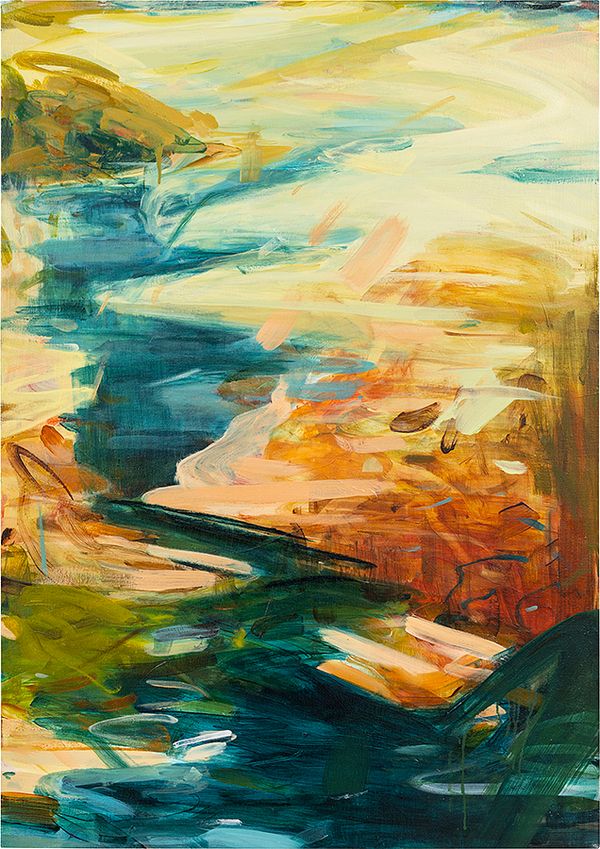Jessie Stevenson, Far in-between, 2022, Whitechapel Gallery Art Icon Charity Auction.
Phillips is once again proud to partner with Whitechapel Gallery for its annual Art Icon Charity Auction — this year in tribute to 2023 honoree Jenny Holzer and benefitting Whitechapel’s pioneering education programs. It comes as no surprise that the sale is led by Holzer's work. Of no less interest are the young painters in the sale, buzzing on the London scene. Phillips speaks with three of them below.
Nature’s Threat — Nick Goss
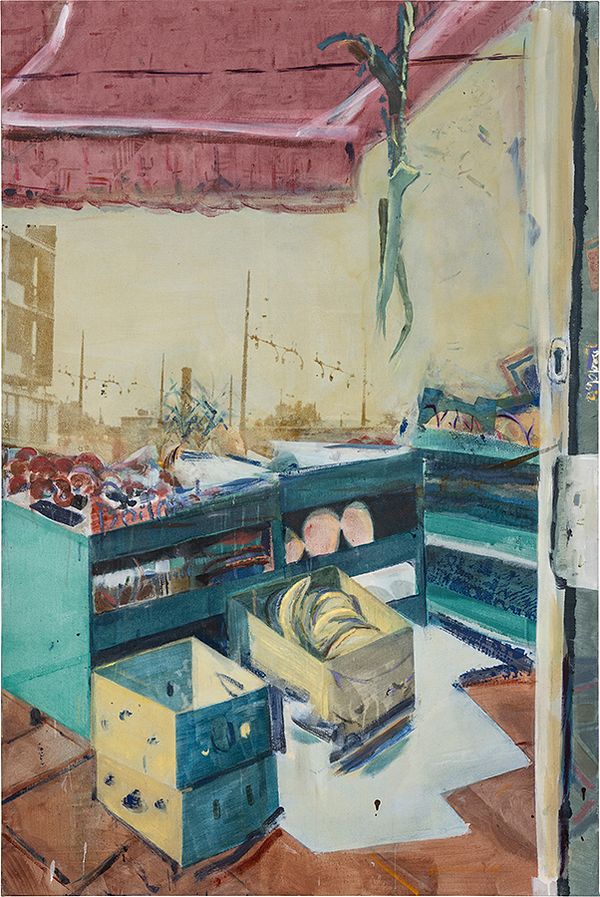
Nick Goss, Aloe Vera, 2022, Whitechapel Gallery Art Icon Charity Auction.
British artist Nick Goss’ fragile and visceral work is emerging as compelling and desirable in today’s scene. Aloe Vera, which the artist donated to the Whitechapel Art Icon Charity Auction, fuses scenes of palm-adorned vendor stalls at London’s street markets with “a second reality made up of a silk-screened cityscape,” drawn from an archival image of a flooded Florence from 1966. His depictions of deluges and floods in uncannily familiar locations echo to the viewer the fragility of our ecosystem and the impermanence of our man-made homes. The work is related to a recent series presented at a solo booth with Josh Lilley Gallery at Frieze London, which is “creating works where time and place appear to be collapsing in on themselves and where a new type of reality is encouraged.”
Phillips sat down with the artist to discuss the present work and heard of his interest in collage as it relates to techniques in filmmaking and electronic music composition, as well as his personal experiences with Whitechapel Gallery. Click below to read more.
Read our full interview with Nick Goss >
In Confrontation — Lydia Pettit

Lydia Pettit, Presentation, 2022, Whitechapel Gallery Art Icon Charity Auction.
In the words of Lydia Pettit, Presentation is among her paintings that are “reframing the relationship I have with my body” and “is one of many focusing on my body and the parts of me I manipulate and stare at in the mirror.” The American-born, London-based painter is a fast-rising star, having graduated with her MA from the Royal College of Art in 2020, with subsequent breakthrough shows at White Cube in London and Galerie Sebastien Bertrand in Geneva.
In her self-portraits of the past six years, there is a tension between the arresting imagery of private misery that directly confronts us, and a gentle sense of relatable, therapeutic intimacy. It’s at once a battle and a gift.
In our discussion, Pettit touched on her oeuvre’s relationship to figurative artists who highlight the experience of the underrepresented, her inspiration from horror films, and what the work of Jenny Holzer means to her. Click below to read more.
Read our full interview with Lydia Pettit >
Sensory Indulgence — Jessie Stevenson
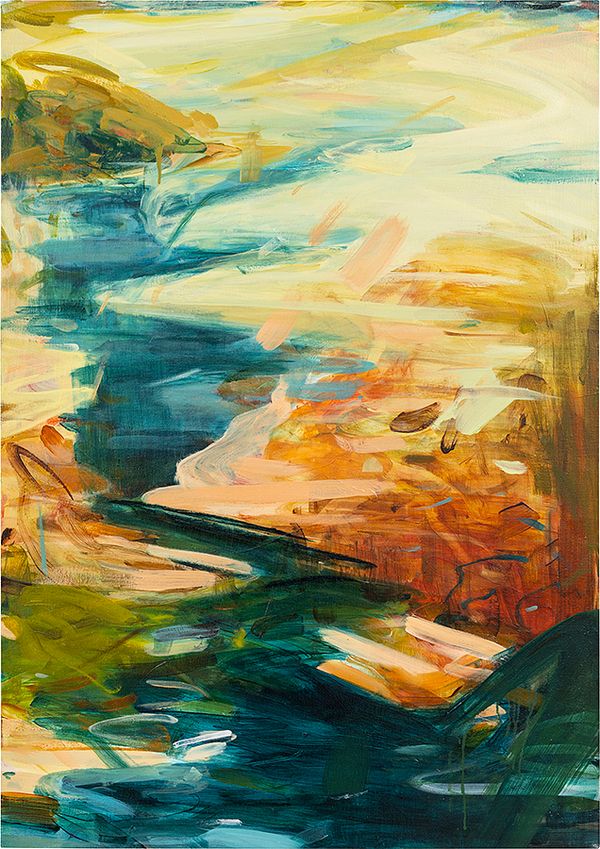
Jessie Stevenson, Far in-between, 2022, Whitechapel Gallery Art Icon Charity Auction.
A painter of lush abstract canvases influenced by the natural world, Jessie Stevenson is rapidly on the rise, having received the Bartolomeu dos Santos Graduate Award upon her 2022 MFA graduation from the Slade School. Her donated work Far in-between (2022) “describes an ethereal marshland which is inspired by the rural landscape from my home in North Norfolk, UK. The abstract view is heightened by the changing perspectival angles and the swathes of phthalo-blue which zig-zag across the painting.”
Stevenson discussed with us her influences ranging from Turner and Delacoix to Wordsworth, her experience of winning The Richard Ford Award, and how her work is inspired by colorways of the contemporary world. Click below to read more.
Read our full interview with Jessie Stevenson >
Phillips Interviews Nick Goss
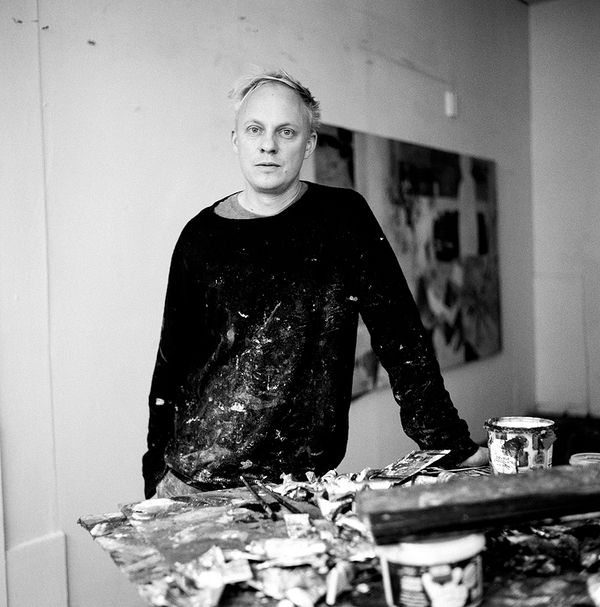
Nick Goss in his studio, London. Photograph: Ben Harries. Courtesy of Ingelby Gallery.
Phillips: Tell us about the work you’ve donated to the Whitechapel Gallery Art Icon Charity Auction.
Nick Goss: My donation is a new painting called Aloe Vera. It is named after the thick leaved palms that ubiquitously hang down in front of stalls in street markets across London. As I walk through Ridley Road market most days to grab some lunch and buy supplies, I will occasionally take photos looking through the stalls selling fruit, meat, and veg. One such photo was the starting point for this painting in which the viewer is asked to look past the vivid branded boxes of fruit and veg and into a second reality made up of a silk-screened cityscape. This landscape comes from an image of Florence when it flooded in 1966. I have been researching and working with archival photos of historic deluges over the last few years as a way of exploring my own family’s history, and a way of considering possible futures that face the city in which I live. Juxtaposing the particular language of silk-screening with painting is a way of exploring painting’s ability to compress and collapse time and place.
P: How does the work relate to the rest of your oeuvre? What is its special significance for you?
NG: This work relates to a series I showed a few months back at a solo booth with Josh Lilley Gallery at Frieze London. The works all place the viewer in a small, even claustrophobic, urban interior looking out into an expansive but unsettling vista. In this series I am attempting to create a new painterly language built up of fragments, splicing the silk-screened prints with passages of more fluid painting. Creating works where time and place appear to be collapsing in on themselves and where a new type of reality is encouraged.
P: How do you see your practice in relation to the broader cultural landscape right now? — are there any movies, songs, books, or trends that are inspiring you and influencing your work at present?
NG: I’m currently intrigued by the idea of collage as a language and its relationship to times of extreme difficulty, and how throughout history trauma and collage go hand in hand. A recent beautiful show of Eileen Agar’s work at the Whitechapel is a good example of this. There is an overriding sense in these new paintings that objects and scenes have been cut and pasted into reality, everyday life collides with something completely outside of itself. There is a fugitive or momentary nature to a lot of great contemporary image making at the moment that I enjoy thinking about and responding to. This idea of image making directly refers to a type of montage filmmaking and decoupage editing (exemplified by the later works of Jean-Luc Godard) and the cut and paste use of samples and electronic ambient music (Tim Hecker, Elysia Crampton) that I listen to in the studio.
P: Describe a particularly meaningful or memorable highlight of your career thus far.
NG: In 2019 I presented a whole new body of work at Pallant House Gallery in Chichester. What was particularly memorable about that project was the opportunity to work with their permanent collection and curate a room with works by Eileen Agar, Paul Nash, Michael Andrews and Prunella Clough.
P: What does Whitechapel Gallery mean to you? Have any exhibitions you have seen there spoken to you and your work?
NG: I lived right behind the Whitechapel Gallery while studying at the Slade and Royal Academy Schools and so its program has had a profound impact on my idea of what art can be. The Hannah Höch exhibition in 2014 has had a lasting impact on my practice and is an exhibition I think about a lot in the studio, more recently I loved the Kai Althoff exhibition. An historic exhibition at the Whitechapel I would have loved to have experienced is This is Tomorrow, that sense of collaboration and a cross-pollination of ideas between the arts is wonderful to think about.
Up Next: Lydia Pettit’s Presentation >
Phillips Interviews Lydia Pettit
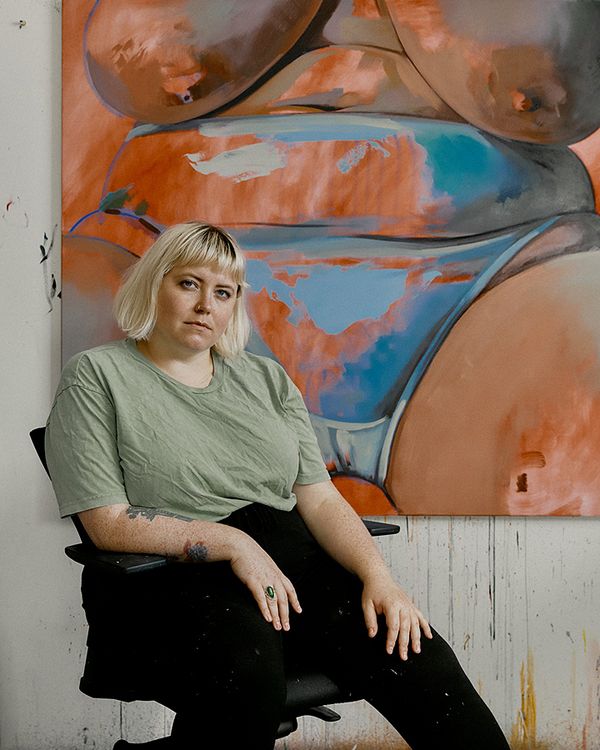
Lydia Pettit. Photo: Jess Ellis.
Phillips: Tell us about the work you’ve donated to the Whitechapel Gallery Art Icon Charity Auction.
Lydia Pettit: My painting Presentation is a piece that reflects the ongoing discussion in my work about reframing the relationship I have with my body. My fat belly is a point of contention in my life, due to my upbringing and the culture of obsession around beauty standards — to have a large belly is an affront, unless you are pregnant. This piece is a confrontation for the viewer and myself, putting this element of me front and center.
P: How does the work relate to the rest of your oeuvre? What is its special significance for you?
LP: This piece is one of many focusing on my body and the parts of me I manipulate and stare at in the mirror— part of the many self-portraits I have made in the past 6 years. Presentation is important the same way every one of my pieces is — it provides an opportunity for me to reckon with and repair and share the therapeutic process of my studio.
P: How do you see your practice in relation to the broader cultural landscape right now? — are there any movies, songs, books, or trends that are inspiring you and influencing your work at present?
LP: I think my work falls in line with the many painters who are supplementing the history of figurative painting with underrepresented experiences and perspectives, in particular frank portraiture about what it's like being a woman and seeing our bodies through our own eyes. Horror films are a massive inspiration for my work. I often use tropes from the genre to describe the experience of living with PTSD and mental illness, and the alienation of the body after experiencing trauma. I highly recommend the film Censor by Prano Bailey-Bond — an excellent example of how one can use the genre to process and discuss pain.
P: Describe a particularly meaningful or memorable highlight of your career thus far.
LP: My solo show online with White Cube was a huge deal for me. I had never experienced that level of exposure or support in my life for my work and felt so proud of what I put forward. It's something I could never have imagined happening after graduating from the Royal College of Art, or ever really.
P: What does Whitechapel Gallery mean to you? Have any exhibitions you have seen there spoken to you and your work?
LP: I really appreciate art spaces that provide community programming and make art accessible to all sorts of people. I'm happy to donate the proceeds of the sale of my work to the education and work that Whitechapel Gallery puts forward! A show that was most impactful for me was Radical Figures, not only was it the last show I saw before Covid but I appreciated the curation and especially the works by Nicole Eisenmann and Tala Madani.
P: How do you see Jenny Holzer’s influence and has she impacted your practice? Do you feel that your work, though different from Jenny Holzer’s, may in some way relate?
LP: I remember when her piece Abuse of Power Comes as No Surprise was spread around at the beginning of the MeToo movement. Though our work is visually very disparate, by consequence of who I am and what I have been through, my work becomes very political as well — in speaking and sharing stories of failing systems, forgiveness, and anger, we connect.
Up Next: Jessie Stevenson’s Far in-between >
Phillips Interviews Jessie Stevenson

Jessie Stevenson in her studio. Courtesy of Berntson Bhattacharjee.
Phillips: Tell us about the work you’ve donated to the Whitechapel Gallery Art Icon Charity Auction.
Jessie Stevenson: The painting Far in-between (2022) describes an ethereal marshland which is inspired by the rural landscape from my home in North Norfolk, UK. The abstract view is heightened by the changing perspectival angles and the swathes of phthalo blue which zig-zag across the painting. It evokes memories of my childhood and suggests the interconnectedness of the Norfolk region and the way it relates to other geological landscapes.
The color palette is influenced by my sketchbook color beginnings, which I made during the winter months. Whilst creating this piece, it provoked ideas about my painting process and the approach of using pure instinct to guide the work. The colors shift and the shapes collide as I physically maneuver the painterly forms throughout the layers.
P: How does the work relate to the rest of your oeuvre? What is its special significance for you?
JS: My work is influenced by the natural world, particularly the wild landscape from the coastline of North Norfolk. Clouds, rhododendrons, marshland, pine trees, and the natural phenomena of light become registers to channel my own experience of memory and place.
Movement is a central theme to my work. Walking, tracing, digging, exploring, I gather visual forms from the differing environments. These incidental moments manifest as a range of marks which I incorporate as part of my artistic lexicon. My pictorial happenings are built over time and jostle between areas on the canvas.
P: How do you see your practice in relation to the broader cultural landscape right now? — are there any movies, songs, books, or trends that are inspiring you and influencing your work at present?
JS: The experience of living and working surrounded by the majestic extremities of nature had a huge impact on my work, particularly tapping into my own personal sublime today. The subject of the landscape becomes a holding device, and it is a way to communicate conversations about escapism and the duality of life in the contemporary climate.
I draw inspiration from the pigments and techniques of Old Masters including J. M. W. Turner and Eugène Delacroix, as well as the Romantic poetry of William Wordsworth. These are combined with contemporary pop culture references, incorporating colorways from fashion advertising.
P: Describe a particularly meaningful or memorable highlight of your career thus far.
JS: Recently, I was presented with The Richard Ford Award and had the opportunity to respond to the museum collection at The Prado, Madrid.
While researching, I came across Francisco Goya’s Los disparates (1815-1823), a series of etchings he made near the end of his artistic career. The disturbing scenes of tangled, fantastical beasts and figures reflect the cruelties of war and the tumultuous societal behavior Goya witnessed at the time. I had access to the museum archives and over the course of one month, I was able to sketch directly from the etchings. It was an incredibly enriching process encountering Goya’s raw emotion up-close and I became interested in the economy of the graphite line to suggest a dark visceral feeling on the paper.
P: What does Whitechapel Gallery mean to you? Have any exhibitions you have seen there spoken to you and your work?
JS: As a student in London, I remember seeing the William Kentridge: Thick Time exhibition (2016) at Whitechapel Gallery. It opened my eyes to the various possibilities of making and the ability to have a multidisciplinary practice within a curatorially immersive space. I am a huge admirer of his work and it continues to inspire my own experimentations with different mediums, such as my 2022 stop-motion animation Not of this noisy world. My automatic drawings became a site-specific sculpture and while waiting for the sun to set, light and time played a key role in the overall performance of the video work at The Pump House, Battersea Park.
P: How do you see Jenny Holzer’s influence and has she impacted your practice? Do you feel that your work, though different from Jenny Holzer’s, may in some way relate? Are there other artists your work is in dialogue with?
JS: The political undercurrent of Jenny Holzer’s work has prompted thoughts on what it means to be living today, and concepts about authority within a perpetually frustrated society. My ideas have been shaped by the pandemic and increasingly the difference between the urban and country vernacular.
Jenny Holzer’s works are stimulated by the power of language. Similarly, my painting titles take inspiration from the lyrical words of William Wordsworth. The text become hooks, almost like a script, allowing the viewer to have their own dialog with the piece.
Rodney McMillian is another contemporary artist I greatly respect. His loose haptic lines depicting trees on unstretched bedsheets continue to intrigue me. He can balance both the materials with authentic intention, while provoking a geo-political subject matter beneath the paint.
Online Auction /
12 – 20 January
Discover More from Whitechapel Gallery Art Icon Charity Auction >
Recommended Reading
2022 Whitechapel Gallery Art Icon Auction >
New Wave: Painting in Britain Today >
